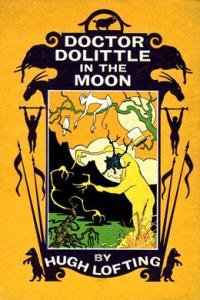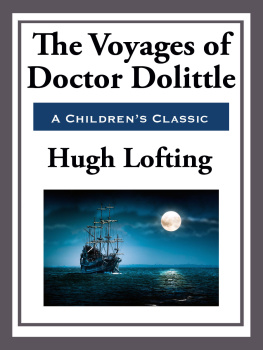Doctor Dolittle's Garden
Hugh Lofting
I suppose there is no part of my life with the Doctor that I, Thomas Stubbins, look back on with more pleasure than that period when I was Assistant Manager of the Zoo.
We had come, as I have told you elsewhere, to call that part of the Doctor's garden "Animal Town." One of my greatest difficulties was in keeping down the membership in the various clubs and institutions. Because of course a limit had to be put on them. The hardest one to keep in check was the Home for Crossbred Dogs. Jip was always trying to sneak in some waif or stray after dark; and I had to be quite stern and hardhearted if I did not want the mongrels' club disorganized by overcrowding.
But while the Doctor and I were agreed that we must keep a fixed limit on all memberships, we encouraged development, expansion and new ideas of every kind on the part of the animals themselves that would help to make Animal Town a more interesting and more comfortable place to live in. Many of these were extremely interesting. Among them was the Dog Museum.
For many years the Doctor had had a museum of his own. This was a large room next to the study where bones, mineral specimens and other naturalhistory things were kept. There is an old saying: Imitation is the sincerest form of flattery. A natural interest in bones often led the dogs to contemplate this display and finally to start a museum of their own.
This was helped to some extent by a peculiar dog who had some months before become a member of the club. The peculiarity of his character was that he had an inborn passion for collecting. Prunestones, umbrellahandles, doorknobsthere was no end to the variety of his collections. He always maintained that his prunestone collection was the largest and finest in the country.
This dog's name was Quetch. He was a great friend of Toby, who had first introduced him and put him up for membership at the club. He was a good second to Toby in upholding the rights of the small dogs at the clubhouse and seeing that they didn't get bullied out of any of their privileges. In fact Blackie and Grab always said that the small dogs, with Toby and Quetch to champion them, bossed the club a good deal more than they had any business to. Well, Quetch it was (he was a cross between a West Highland terrier and an Aberdeen) who first suggested the idea that the Mongrels' Club should have a museum of its own. With his passion for collecting, he was probably counting on getting the job of museum curator for himselfwhich he eventually did. The House Committee met in solemn council to discuss the pros and cons and ways and means. The idea was finally adopted by a large majority vote and a section of the gymnasium was screened off to form the first headquarters of the museum.
Quetch (he was always called "Professor" by the other members of the club)Professor Quetch, besides being a keen scientist, had a genius for organization almost as good as the white mouse's. And even he could not find fault with the general enthusiasm with which the Dog Museum was supported, and contributed to, by the members of the club. There was hardly a dog in the Home who didn't turn to collecting and bringing in material. And Quetch the curator had his paws more than full receiving and arranging the continuous flow of specimens of every kind that poured in.
The Museum was not confined to natural history. It was also an archological or historical museum. The bones department was perhaps the largest. Personally, I don't think that any student of comparative anatomy would have found it scientifically very helpful. For the bones were mostly beef, mutton and ham bones.
But not all. There were fish bones. In fact there was one whole fish, which Professor Quetch proudly ordered me to label, "The Oldest Fish in the World" I could well believe it was. Blackie the retriever had dug it upfrom the place where some one had carefully buried it a long time ago. Its odour was so farreaching that the members of the Badgers' Tavern (which was at least a hundred yards away from the Home for Crossbred Dogs) sent in a request that something be done about it. They said that while they were not usually oversensitive to smells, this one kept them awake at night. Professor Quetch was very much annoyed and sent a message back to the badgers that they were a lot of lowbrow, meddlesome busybodies who didn't appreciate science. But some of the Doctor's neighbours across the street also complained; and the "oldest fish in the world" had to goback to the garbage heap.
"Professor Quetch"
The archological side of the Dog Museum was even more varied and extensive than the natural history departments. Here could be found Quetch's own priceless collection of prunestones, umbrella handles and doorknobs. But these formed only a small part of the whole. The habit of digginggenerally for ratsnatural to all dogs, now led to the unearthing of treasures of every variety. Saucepanlids, bent spoons, top hats, horseshoes, tin cans, pieces of iron pipe, broken teapots, there was hardly anything in the way of hardware and domestic furnishings that wasn't represented. A sock which had been worn full of holes by the great Doctor himself was one of the most sacred and important exhibits.
For the first few days there was a general frenzy of digging. Jip and Kling had heard the Doctor say that the Romans had once had a military camp on the site now occupied by the town of Puddleby. They were determined that they'd find Roman jewelry if they only dug patiently enough. Among other places they tried was Colonel Bellowes' tulip bed. They had just dug up a bulb when they were seen by the Colonel and chased. But they got awayand home with the bulb. And that was how the Botanical Department of the museum began. The bulb in question had a label set under it reading:
"This Orchid was donated by the famous naturalist and explorer, Jip. The intrepid collector was disturbed at his work and chased for miles by savage natives. He eluded his pursuers however and succeeded in bringing back this priceless specimen to the Dog Museum."
"They were seen by the Colonel and chased"
The Dog Museum continued for much longer than I had thought it would. My private opinion had been that the dogs were only captivated by the novelty of the idea and would drop it altogether when its newness had worn off. Some weeks after its beginning the collections had grown so fast that they filled the whole gymnasium. During the semifinal bout of a wrestling contest a Great Dane threw Blackie the retriever through the dividing screen and landed him in the middle of the Botanical Department. It was clear that the gymnasium was getting crowded out by the museum.
"The semifinal bout of a wrestling contest"
So a second meeting of the House Committee was called. And it was decided that since athletics were equally important as science, most of the junk should be thrown out, and only those things kept that were really genuine and of special application to dogs and Dog History.
Jip's famous golden collar (which he only wore on holidays and occasions of importance) was made one of the star exhibits. There were also a few bones which Professor Quetch insisted had been chewed by the great dogs of history. There was, also, a small keg which he said had been carried round the necks of the St. Bernard dogs who went to the aid of lost travellers in the snowswept passes of the Alps. How he knew the record of these relics no one could tell. On the other hand, no one could deny it when he put up a label under a veal bone saying that this object had been the earliest plaything of the Empress Josephine's pet poodle.
At all events, the enormous array of hardware and rubbish which had formed the first displays gave place to one or two glass cases where a small collection of objects of great virtue was set forth. And for many years these remained a permanent part of the institution, and all visitors, whether dogs or people, were shown them. Professor Quetch never allowed visitors into the museum, however, without personally conducting them, to see that they didn't lean on the casesif they were peopleor, if they were dogs, that they didn't take away the historic bones.







